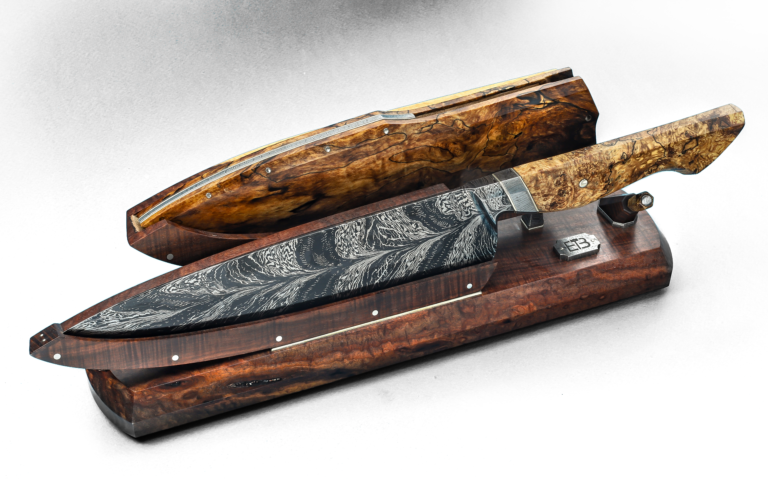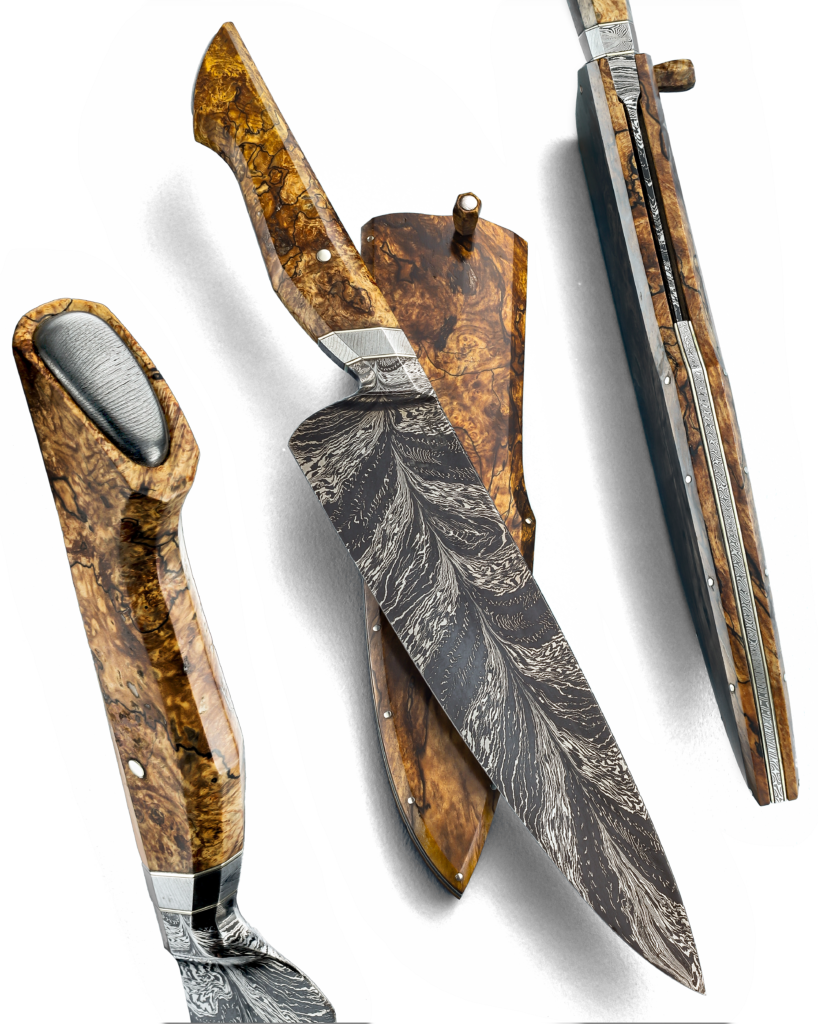
One-piece custom-made chef’s knives embody strength, balance, line and flow and more
By Mike Haskew
As it does in other aspects of custom knives, integral construction, with blade bolster, tang and pommel forged from a single piece of steel, has its application in the kitchen. The high-performance chef ’s knives that result from such a construction provide an excellent opportunity for skilled knifemakers to showcase their abilities. Function is always at the forefront. After all, First and foremost, all knives must cut. So, chopping, slicing and dicing ability, comfort in the user’s hand, edge-holding properties, and easy maintenance and upkeep are prerequisites. To step it up, consider chef ’s knives that blend the basics in their efforts to raise the game. Good looks are indeed a bonus, and the featured models deliver with delicious damascus, tantalizing handles and overall presentation that will keep you in the kitchen just for the sheer pleasure of manipulating them.
FORM & FUNCTION TO CONSIDER FOR CUSTOM CHEF KNIVES
When Gabe Mabry of Norwood, North Carolina, cooked up a kitchen stunner with a 300-layer ladder-pattern damascus blade forged in partnership with Steve Grosvenor, he took the principles of form and function to heart.
“There’s something about an integral chef ’s knife,” he said. “Forging it connects bladesmiths to their forebears. With all the modern technology, there’s only one way I can think of to manufacture an integral chef ’s knife—and that’s to forge it to shape. A well-executed integral will have impeccable balance and design flow that seems intuitive. Conversely, much toil went into the shape.”
Mabry’s piece was constructed for a specific client order. The damascus is forged from a combination of 80CrV2, 52100 and CruForge V carbon and 15N20 nickel-alloy steels. e handle of ancient walrus ivory is tapered with a slight curve and accented with the owner’s initial in the butt.
“The construction of an integral is a labor of love,” Gabe commented. “However, all the work and care of setting up the bolster makes the handle assembly simpler to a degree, with the inclusion of up to an inch of metal in the bolster. is inch of material can be subtracted from the handle material, increasing the options in handle materials. Integral knife construction adds multiple steps and a degree of difficulty as well.”
While the fundamentals of any good working knife must be incorporated into the integral, the construction itself doesn’t apparently add or detract from the user’s experience. Balance, edge, comfort and dexterity, durability and cleanup still matter. And the last attribute is perhaps one where an integral has an advantage.

“An integral knife has its benefits,” offered Charlie Ellis of Eagle Crest Forge in Asheville, North Carolina. “And when done well it is very strong, with a minimal number of joints to become problems with material movement or becoming a possible breeding ground for bacteria. Also, it minimizes potential issues with wood movement. Having the joint positioned where there is the least chance of movement and using stable material is a wise choice.”
The HEXAGRAL CUSTOM MADE CHEF KNIFE
Ellis created a beautiful integral chef’s knife with a 10-inch damascus blade of 1095 spring and 15N20 nickel-alloy steels in a radial laddered W’s pattern, and an “S” grind for less resistance in the cut and better food release. The handle is African blackwood with silicon bronze and G-10 fittings. “It’s big but light for its size and balanced perfectly for a pinch grip,” Ellis explained.
The knife is fashioned in a distinctive style Charlie calls the hexagral. “I call this design the hexagral as a nod to my friend [and ABS master smith] Haley DesRosiers, who makes octagonal-shaped integrals she calls octagrals. With the hexagral, the integral bolster is shaped in a hexagon, both in cross-section and, quite challengingly so, on the faces.
“Compared to typical hidden-tang construction that is limited by the spine thickness, an integral can have a truly robust tang. Also, with this knife, the tang runs through to be bolted and capped on the end so that if for some reason the ep- oxy failed, there is a mechanical connection keeping it tight.
“So,” he continued, “while there are some practical bonuses to an integral, I would have to say that what draws me to them, and why I choose to make them the most, is their artistic potential. Seeing the pattern condensed in the bolster and then flowing out into the blade is always one of my favorite parts. Between that and the sculptural aspect of the transition between the blade and handle, there are so many interesting possibilities. I al- ways get excited with each new integral I create.”
Brent Stubblefield of Join or Die Knives in Richmond, Virginia, finds the challenge of integral construction one of the most appealing aspects of the undertaking. “Integral-construction chef’s knives are special because the production meth- od cannot be counterfeited,” he reasoned. “Standard stock removal processes can- not be used to make them, and machining processes, while an art unto themselves, cannot produce the flowing patterns that a forged damascus blade can.”

For Stubblefield, the integral’s functional advantage lies in the flow of the handle, its uniqueness and strength rather than any perceived upgrade in edge performance. Integral construction, he says, should provide a blank canvas for the maker to use any shape or geometry desired. In this case, the style does not inherently improve edge geometry but al- lows for infinite possibilities.
“Larger stock must be used for integral construction,” he explained. “I usually use at least 1-inch round stock and, when making damascus, I leave the stock at 1 inch by 2 inches, plus the desired length. There must be enough thickness to leave material for the bolster and tang as well as drawing them out, and there must be enough blade material to draw the heel back toward the handle. In considering integral. hidden-tang-with-guard and full-tang knives, each has its pros and cons Quality material plus excellent fit and finish bring those differences down to the level of nuance. The standout advantage of the integral is the strength of the seamless connection of blade and bolster.”
“A WELL-EXECUTED INTEGRAL WILL HAVE IMPECCABLE BALANCE AND DESIGN FLOW THAT SEEMS INTUITIVE.” -GABE MABRY
Brent’s chef’s knife has an 80-layer ladder pattern damascus blade forged from 1084 carbon and 15N20 nickel-alloy steels. The blade features an “S grind with hollow ground cheeks while the cutting edge is flat ground up to about one-half inch above the edge to assist in food release. The Virginia maple burl handle is fashioned in the style of French Sabatier chef’s knives with extra wood at the end to help balance the longer blade. A G-l10 spacer provides a subtle accent.
“Integral knives have fewer seams when built in a hidden- tang fashion, he added. “There are no inside corners where handle or bolster material terminates. So, the integral may be easier to keep clean and free of food particles. Although we do our best to seal our handle material to the tang with epoxy, there is always a possibility of liquid intrusion, So, the more seams around the tang, the more chances of infiltration. I’m building knives with the intention for multiple lifetimes of use, so I prefer any advantage for longevity.”
ADDED STEEL MASS
Jason Ellard of Coningham, Tasmania Australia, built a mosaic integral chef’s knife with an 8.86-inch blade of feathered damascus in 1084 and 1SN20 steels, spalted sassafras burl handle with a domed pin and twist damascus inlay, and an accompanying sheath in frame construction and nickel-silver and twist damascus to match the spacer. Overall length: 14.76 inches.

“The forward angle of the bolster- blade transition allows for easier stone sharpening,” remarked Jason. “Handle spacers are made from nickel-silver and twist damascus with broken edges for a nice feel. The handle also has proven edges, which help with stopping a hard ridge at the transition if the wood ever swells or shrinks. I carved out a recess to allow the bolster to fit inside the sheath, and the stand is ringed gidgee with damascus pegs raising the back portion and a nickel-silver plate under the front section. The sheath pin has a twist damascus inlay and its own designated holder on the stand. Lastly, I created a mosaic damascus logo plate pinned onto the base of the stand.”
Ellard approaches integral construction with a full understanding of its difficulty. “It takes a lot of skill in every aspect of creating it,” he observed, “and even more so to do it well. The forging, grinding, symmetry, handle fitting, and hand finishing are all a lot more difficult to do than other constructions, and it’s a major staple of a skilled maker to do this with a high level of quality. I person- ally just enjoy making integral knives a lot more. I find it more pleasing to the eye, and I enjoy the added challenges in creating them, allowing me to show what my skills are capable of.”

According to Jason, the added steel mass of the integral will always make the knife more solid and heavier than other types. Performance is a key attribute, though other kitchen knives are comparable in many ways. “The performance shouldn’t be affected negatively or positively as long as the knife is made correctly,” he noted. “The lack of a hard 90-degree at the ricasso in a hidden-tang knife can make cleaning a lot more difficult. It also makes it easier for debris or moisture to get into the handle. With the integral construction moving the seam further back, it takes these issues away very well. I’ve also found it easier to get a tight fit against an integral bolster than a hidden- tang ricasso.”
Integral construction in a chef’s knife adds another dimension to the artistry that is custom knifemaking. In fact, an appreciation of the skill and execution of the integral may actually push the chef to new heights of culinary creation.
 NEXT STEP: Download Your Free KNIFE GUIDE Issue of BLADE Magazine
NEXT STEP: Download Your Free KNIFE GUIDE Issue of BLADE Magazine
BLADE’s annual Knife Guide Issue features the newest knives and sharpeners, plus knife and axe reviews, knife sheaths, kit knives and a Knife Industry Directory.Get your FREE digital PDF instant download of the annual Knife Guide. No, really! We will email it to you right now when you subscribe to the BLADE email newsletter.






